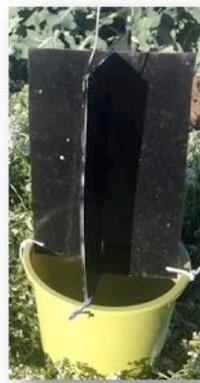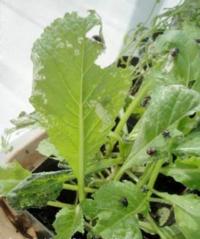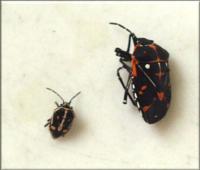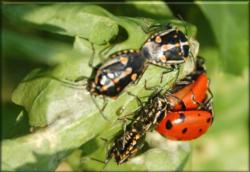Bagrada Bug Discovery
We knew it would happen sooner or later—the Bagrada bug has made an appearance in Sacramento County. On November 10, 2014, an adult Bagrada bug was discovered by UC Master Gardener Gail Pothour on a mustard plant in the vegetable demonstration garden at the Fair Oaks Horticulture Center. This was the first official find in Sacramento County. Since that find, monitoring for this insect was ongoing within the vegetable demonstration garden, and many more have been found in 2015.
A study was conducted by UC Cooperative Extension in Monterey County (Salinas) in 2013 to develop baseline information about Bagrada bug trapping. Using cross-vane traps in various colors, it was found that the color black caught the most Bagrada bugs (see photo below). As a way to monitor the presence of Bagrada bugs at the FOHC, a cross-vane trap was built and placed into one of the raised beds in the vegetable demonstration garden.

Since the most bugs in the Monterey County study were attracted to the black traps, we painted ours black. Our trap was placed within a solid planting of sweet alyssum (one of the bug's preferred host plants) based on what was done in the Monterey County study.
After several months, no Bagrada bugs were found, at least not until July 22, 2015, when six dead adult Bagrada bugs were found in the soap solution at the bottom of the trap. Upon close inspection of the sweet alyssum flowers, another 25 adults were found, most of which were in the process of mating. In subsequent days, more adult Bagrada bugs were found, many of which were mating pairs. It appears that the sweet alyssum has done its job in attracting the bugs, and the cross-vane trap also was somewhat successful in capturing some of them.
The Bagrada bug is very small. In fact, it is often confused with lady beetles—adults are about the same size (¼ inch) and nymphs look a lot like adult lady beetles. An adult Bagrada bug has markings similar to adult harlequin bugs, but an adult harlequin bug is more than three times the size of an adult Bagrada bug and has no white markings.
| © 2009 Daniel Marlos | Photo courtesy www.whatsthatbug.com | |
Bagrada bug (Bagrada hilaris) is an invasive stink bug that is native to Africa. In the U.S. it was first found in Los Angeles County in 2008, and it spread throughout southern California and moved northward to Fresno, Tulare, and Monterey counties. Late in the summer of 2014, Bagrada bugs were found in Yolo County, specifically on farms in the Capay Valley and near Esparto.

Bagrada bugs prefer plants in the mustard family (Brassicaceae), such as sweet alyssum, candytuft, broccoli, cabbage, cauliflower, collards, kale, radish, rutabaga, and weeds such as London rocket, shepherd’s-purse, and wild mustard. Even though Bagrada bugs prefer cool-season cole crops (brassicas), their development is favored by warmer temperatures. Adults tend to fly when temperatures are above 85°F. They reportedly also feed on strawberries, melons, carrots, and members of the nightshade (potatoes, peppers, tomatoes), mallow (okra, cotton), legume, and grain families (wheat, corn, sudangrass, millet), as well as sunflowers.
Check out Bagrada bug Pest Note #74166 for additional information and to see photographs of the Bagrada bug. You can also view a presentation (PDF 3MB, new window/tab) with excellent photos given by Dick Hoenisch (UCD Plant Pathology Department).
If you think you have the Bagrada bug on any of your plants, please place it in a sealed plastic bag or container and take it to the Master Gardener office, 4145 Branch Center Road, Sacramento, Monday through Thursday, 9:00 a.m. to 12:00 noon or 1:00 to 4:00 p.m. The office is closed on Friday. Alternatively, e-mail a clear photo to mgsacramento@ucanr.edu or call (916) 875-6913.





